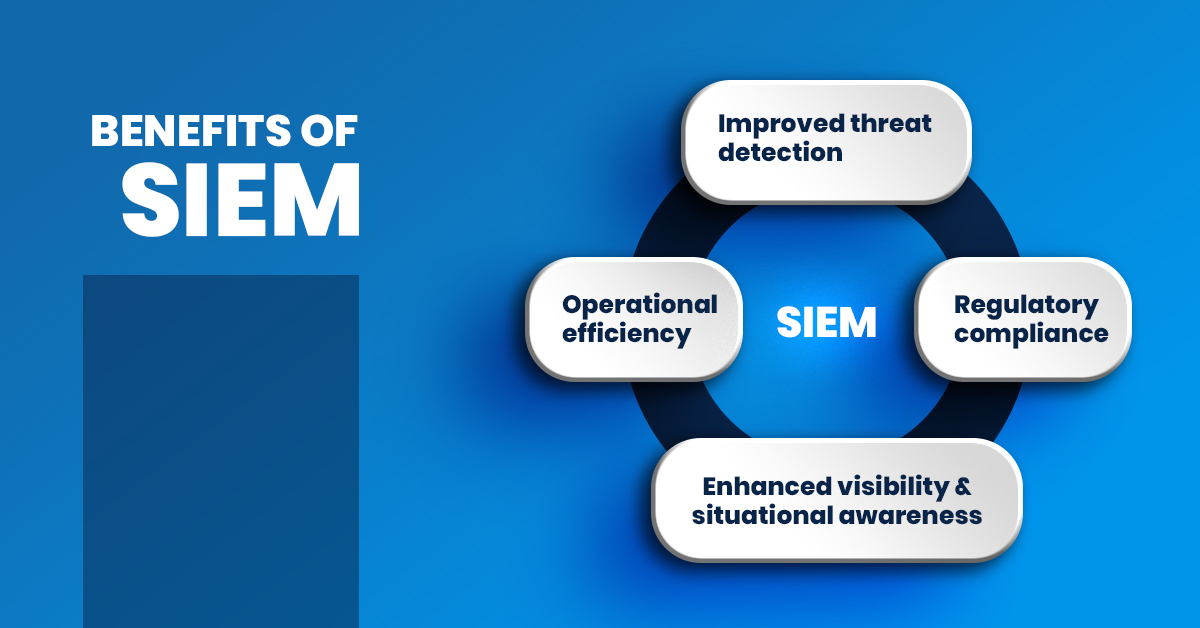Benefits of SIEM

Security Information and Event Management (SIEM) systems offer several benefits to organizations by providing a centralized platform for monitoring, analyzing, and responding to security events. Here are key benefits of implementing a SIEM solution:
-
Centralized Log Management:
- Benefit: SIEM systems centralize log data from various sources across the organization, providing a single point of access for monitoring and analysis. This facilitates efficient log management and reduces the complexity of dealing with dispersed logs.
-
Real-Time Event Detection:
- Benefit: SIEM tools analyze log data in real-time, enabling organizations to detect security incidents promptly. This allows for a rapid response to emerging threats and helps minimize the impact of security incidents.
-
Correlation of Events:
- Benefit: SIEM systems correlate events from different sources, allowing security teams to identify patterns and relationships that may indicate sophisticated attacks or unusual activities. Correlation enhances the accuracy of threat detection.
-
Automated Alerting:
- Benefit: SIEM tools generate automated alerts when suspicious or potentially malicious activities are detected. Automated alerting ensures that security teams are promptly notified, allowing for quick investigation and response.
-
Incident Response Improvement:
- Benefit: SIEM systems facilitate incident response by providing detailed information about security incidents. This information includes the timeline of events, affected systems, and contextual data, helping security teams investigate and remediate incidents more effectively.
-
Comprehensive Visibility:
- Benefit: SIEM solutions provide comprehensive visibility into the organization's IT environment. Security professionals can gain insights into user activities, system events, and network traffic, allowing for a holistic view of the security posture.
-
Threat Intelligence Integration:
- Benefit: SIEM tools often integrate with threat intelligence feeds, enabling organizations to stay informed about the latest threats and vulnerabilities. This integration enhances the ability to detect and respond to emerging cyber threats.
-
User and Entity Behavior Analytics (UEBA):
- Benefit: Some SIEM systems incorporate UEBA capabilities to monitor and analyze user behavior and entity activities. This helps in detecting insider threats, compromised accounts, or abnormal patterns that may indicate security risks.
-
Regulatory Compliance:
- Benefit: SIEM solutions assist organizations in meeting regulatory compliance requirements by providing features for log management, audit trails, and reporting. Compliance reports can be generated to demonstrate adherence to specific regulations.
-
Historical Analysis and Forensics:
- Benefit: SIEM systems store historical log data, allowing for retrospective analysis and forensic investigations. This capability is valuable for identifying the root cause of security incidents and understanding the full scope of an attack.
-
Continuous Monitoring:
- Benefit: SIEM tools support continuous monitoring of the organization's security posture, helping to identify and respond to security events in real-time. Continuous monitoring is essential for proactive threat detection and prevention.
-
Efficiency in Log Analysis:
- Benefit: SIEM solutions automate the analysis of large volumes of log data, providing security teams with actionable insights. This efficiency enables organizations to effectively manage and respond to security events, even in complex environments.
-
Improved Security Posture:
- Benefit: Overall, SIEM contributes to an organization's improved security posture by enhancing its ability to detect, respond to, and mitigate security threats. This proactive approach strengthens cybersecurity defenses.
While SIEM systems offer numerous benefits, it's important to note that successful implementation and utilization require ongoing maintenance, configuration adjustments, and a commitment to evolving with the changing threat landscape.
Thank you.
